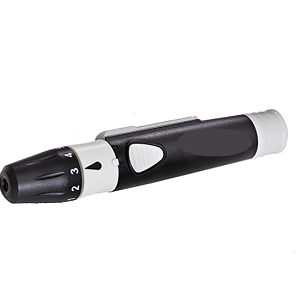Unilet® Excelite and Autolet® Plus Lancing Device
Lancets are designed to create a tiny puncture in the skin, allowing a small drop of blood to be collected. This drop of blood is then used for testing, such as checking blood sugar levels with a glucose meter.
A lancet is usually a small, sterile needle encased in a plastic holder. The needle is designed to be very thin and short to minimize discomfort and pain.
Lancets are used in conjunction with a lancing device, which is a tool that helps to deliver the lancet and puncture the skin. The lancing device can be adjusted to control the depth of the puncture, which can be important for different skin thicknesses.

Demonstration Videos
Start with a low setting, such as penetration depth 2, when using the device for the first time. Dial to a higher setting until the blood volume is right.
Keep in mind, it’s best to always talk with your healthcare professional before deciding if alternate site testing is right for you.
Using your Accu-Chek Softclix lancing device:
First, you will need an Accu-Chek Softclix lancet and device.
Remove the cap from the lancing device.
Insert the lancet into the lancet holder at the bottom of the device – push it all the way in until it clicks in place.
Twist and remove the protective cap from the lancet to expose the needle.
Place the cap back onto the lancing device, ensuring that the notch of the cap aligns with the mark on the device.
Set the penetration depth to match your skin type, by turning the dial on the cap.
To use the lancing device, prime it by pressing the plunger all the way down. The release button on the side of the device should turn yellow, indicating that it is ready to use.
Place the device up against your finger firmly, and press the release button to release the lancet.
Be sure to replace the lancet every time you use your device, as they are not reusable and become unsterile after one use.
To remove the used lancet, take off the cap from the lancing device and slide down the ejector over a sharps disposal bin. Then replace the cap.
This video gives visual instructions on how to set up, load and use the Accu-Chek Softclix lancing device.
Additional Information
OneTouch Verio Flex® – Removing the Used Lancet
Products
OneTouch Verio Flex® meter
Removing The Used Lancet:
- Note:This lancing device has an ejection feature, so you do not have to pull out the used lancet.
- Remove the lancing device cap.
- Removethe cap by rotating it and then pulling it straight off the device.
- Cover the exposed lancet tip.
- Before removing the lancet,place the lancet protective cover on a hard surface then push the lancet tip into the flat side of the disk.
- Eject the lancet.
- Holdingthe lancing device directed downwards, push the slider forward until the lancet comes out of the lancing device. If the lancet fails to eject properly, cock the device then push the slider control forward until the lancet comes out.
- Replace the lancing device cap.
- Placethe cap back onto the device; turn the cap or push the cap straight in to secure it.
- Ensure the cap is aligned as shown in the image.
- It is important to use a new lancet each time you obtain a blood sample. Do Notleave a lancet in the lancing device. This will help prevent infection and sore fingertips.
Disposing Of The Used Lancet And Test Strip:
- Discard the used lancet carefully after each use to avoid unintended lancet stick injuries. Used lancets and test strips may be considered biohazardous waste in your area. Be sure to follow your healthcare professional’s recommendations or local regulations for proper disposal.
- Washhands thoroughly with soap and water after handling the meter, test strips, lancing device and cap.
Reference Links
- OneTouch Verio Flex® – Product Guide
- OneTouch Verio® Test Strips – General Information
- OneTouch Verio Flex® – Sampling Blood from the Fingertip
- OneTouch Verio Flex® – Getting to Know Your OneTouch® Delica® Plus Lancing Device
- OneTouch Verio Flex® – Preparing Your OneTouch® Delica® Plus Lancing Device
- OneTouch Verio Flex® – Caring for Your System
Similar Instructions

